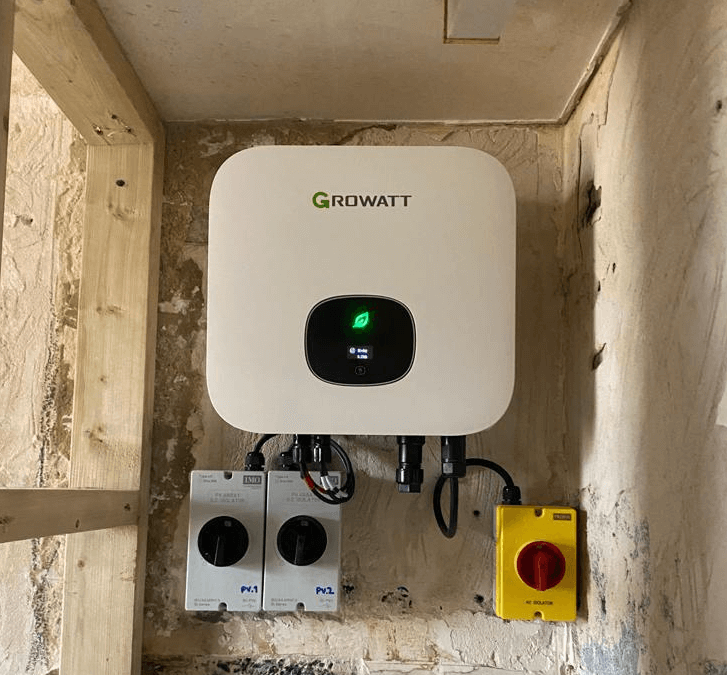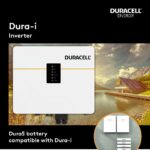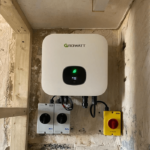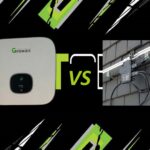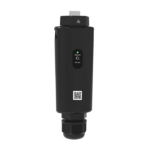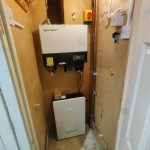Solar Inverters
Solar inverters are crucial for converting the direct current (DC) electricity generated by your solar panels into alternating current (AC) electricity for use in your home. The placement of your solar inverter can impact the efficiency and overall performance of your solar energy system.
Things to consider when choosing where to place your solar inverter
Choosing the right location for your solar inverter is a critical decision in the process of setting up a solar PV system for your home or business. The inverter plays a crucial role in converting the direct current (DC) electricity generated by your solar panels into alternating current (AC) electricity that can be used to power your appliances and be sent back to the National Grid. Here are some important factors to consider when deciding where to place your solar inverter:
- Proximity to Solar Panels: Ideally, the solar inverter should be located as close as possible to your solar panels. This minimizes energy loss due to long cable runs, reducing voltage drop and increasing overall system efficiency. If you have a string inverter (one central inverter for all panels), it should be placed near the center of your solar array. For microinverters or power optimizers, each one should be placed near its respective panel.
- Weather Protection: The inverter should be shielded from extreme weather conditions such as direct sunlight, rain, snow, and excessive heat. Choose a location that offers protection from the elements to ensure the inverter’s longevity and performance. An outdoor-rated inverter enclosure or wall-mounted box can provide the necessary protection.
- Adequate Ventilation: Solar inverters generate heat during operation, and they require proper ventilation to dissipate this heat. Ensure that there is adequate airflow around the inverter to prevent overheating. Installing it in a well-ventilated area or adding a fan if necessary can help maintain a suitable operating temperature.
- Accessibility for Maintenance: Consider ease of access for maintenance and servicing. Inverters may require occasional maintenance or repairs, so ensure that the chosen location allows for easy access. Avoid obstructing the area with obstacles or placing it in an inaccessible location.
- Noise Levels: Inverters can produce some noise while operating, especially if they have fans or cooling systems. If noise is a concern, choose a location that is not too close to living or working areas. Alternatively, you can opt for inverters designed to be quieter.
- Security: Inverters can be attractive to thieves due to their value. Consider security measures like installing a lockable enclosure or placing the inverter in a less visible location to deter theft.
- Electrical Codes and Regulations: Ensure that the installation complies with local electrical codes and regulations. Different regions may have specific requirements for inverter placement, wiring, and safety measures. Consulting with a professional installer like NXTGEN Energy or electrician is advisable.
- Future Expansion: If you plan to expand your solar panel array in the future, consider whether the chosen location can accommodate additional inverters or handle increased electrical load.
- Aesthetics: The appearance of the inverter and its placement can impact the aesthetics of your property. Choose a location that minimizes visual impact if aesthetics are a concern.
- Monitoring and Communication: Ensure that the inverter location allows for easy access to monitoring and communication devices, such as Wi-Fi or Ethernet connections, to enable real-time monitoring of your solar system’s performance.
Ultimately, the right location for your solar inverter will depend on your specific circumstances, the type of inverter you have, and your local conditions and regulations. Consulting with a qualified solar installer like NXTGEN Energy is crucial to making an informed decision and optimizing the performance and longevity of your solar power system.
Near Your Main Electrical Panel
Solar inverters are typically installed near your main electrical panel, which simplifies the connection to your home’s electrical system. This placement minimizes energy losses and ensures efficient energy distribution.
In a Shaded Area
While it’s important to keep solar panels exposed to sunlight, solar inverters should be placed in a shaded area or inside an enclosure to protect them from direct sunlight and extreme heat. Overheating can reduce their lifespan and efficiency.
Wall Mounting
Wall mounting is a common method for installing solar inverters. Ensure the wall is sturdy, and the inverter is mounted at a convenient height for maintenance and monitoring.
Best locations to install a Solar Inverter
Solar inverters are an essential part of your solar panel system setup, allowing you to convert the direct current (DC) that is produced from your solar panels into alternating current (AC) that can be used by your home or business appliances. Here are some considerations for the best placement of a solar inverter in your home:
Hallway
One intriguing possibility is installing a solar inverter in your hallway, an often-overlooked space in many homes. Below, I’ll explore the unique advantages, considerations, and the installation process of placing a inverter in a hallway.
Advantages of Installing a Solar Inverter in Your Hallway:
- Space Utilization: Hallways are typically underutilized areas in homes, making them an excellent choice for housing a solar inverter. By installing it here, you can make the most of this space while keeping it unobtrusive.
- Proximity to Electrical Systems: Hallways are usually close to the main electrical panel, simplifying the connection of the solar inverter to your home’s electrical system. This proximity can reduce installation costs and streamline the entire process.
- Temperature Control: Hallways typically maintain a moderate indoor temperature, which can be ideal for a solar inverter’s efficiency and longevity. This controlled environment helps ensure that the inverter operates optimally.
Considerations for Installing a Solar Inverter in Your Hallway:
- Space Availability: Assess the available space in your hallway to ensure it can accommodate the solar inverter’s dimensions while allowing for proper ventilation and easy access. Hallways should remain clear and unobstructed for safety reasons.
- Ventilation: Proper ventilation is essential to prevent overheating of the solar inverter. Consider adding fans or vents to maintain a stable temperature within the hallway.
- Safety Precautions: Ensure that the solar inverter is securely fastened and protected against accidental contact or tampering, especially if you have children or pets in the household.
- Electrical Connections: Consult with a licensed electrician to ensure correct electrical connections between the solar inverter, solar panels, and your home’s electrical system. Comply with local electrical codes and safety standards.
Placing a solar inverter in your hallway is a creative and efficient way to utilize a typically overlooked space. With attention to space availability, ventilation, safety precautions, and electrical connections, you can successfully integrate a solar inverter into your hallway, harnessing solar power while maintaining the aesthetics and functionality of your home.
Under the Stairs
One intriguing option is installing a solar inverter under the stairs, a space often underutilized in many homes.
Advantages of Installing a Solar Inverter Under the Stairs:
- Space Optimization: Under-stair spaces are frequently overlooked and can be efficiently used to house a solar inverter, maximizing your home’s square footage.
- Aesthetically Discreet: The placement of a solar inverter under the stairs is discreet and doesn’t disrupt the overall aesthetics of your home. It remains hidden from view while performing a vital function.
- Temperature Control: This location often maintains a stable indoor temperature, which is beneficial for the solar inverter’s efficiency and longevity. It helps ensure consistent and optimal performance.
Considerations for Installing a Solar Inverter Under the Stairs:
- Space and Accessibility: Assess the available space under the stairs to confirm that it can accommodate the solar inverter and allow for proper ventilation, wiring, and easy access for maintenance.
- Ventilation: Ensure that there’s adequate ventilation in the under-stair space to prevent overheating. Consider installing fans, vents, or ducts to maintain a controlled temperature.
- Safety Precautions: Implement safety measures to protect the solar inverter from accidental contact or tampering, particularly if you have children or pets.
- Electrical Connections: Consult with a licensed electrician to ensure the correct electrical connections between the solar inverter, solar panels, and your home’s electrical system. Comply with local electrical codes and safety standards.
Installing a solar inverter under the stairs is a creative and space-efficient approach, with attention to space and accessibility, ventilation, safety precautions, and electrical connections, you can successfully integrate a solar inverter beneath your staircase. This allows you to harness solar power efficiently while maintaining the unobtrusive appearance of your home.
Garage or Utility Room
One of the most common locations for solar inverter installation is in a garage or utility room. I’ll explore the advantages of placing a solar inverter in these spaces, key considerations, and how to ensure a successful installation.
Advantages of Installing a Solar Inverter in Your Garage or Utility Room:
- Convenient Accessibility: Garages and utility rooms are often easily accessible, making it convenient to monitor and maintain your solar inverter. This proximity simplifies routine checks and ensures prompt response to any issues.
- Temperature Control: These indoor spaces typically maintain a moderate temperature range, which is ideal for a solar inverter’s efficiency and longevity. Unlike outdoor placements, where extreme temperatures can affect performance, indoor locations offer more stable conditions.
- Space Optimization: Solar inverters require a dedicated area, and placing them in a garage or utility room frees up valuable outdoor space. This is especially beneficial if your property has limited room for outdoor enclosures.
Considerations for Installing a Solar Inverter in Your Garage or Utility Room:
- Ventilation: Adequate ventilation is crucial to dissipate heat generated by the solar inverter. Ensure your garage or utility room has proper ventilation systems in place to prevent overheating.
- Space Availability: Evaluate the available space in your chosen location. Solar inverters come in various sizes, so choose a spot that accommodates your inverter’s dimensions while allowing ample room for ventilation and easy access.
- Electrical Connections: Coordinate with a licensed electrician to ensure that the solar inverter is correctly wired to your solar panels and home’s electrical system. Compliance with local building codes and safety standards is essential.
- Safety Precautions: Install the solar inverter in a secure enclosure to prevent unauthorized access and protect it from damage.
Placing a solar inverter in your garage or utility room is a practical and space-efficient choice that offers convenience, temperature control, and optimization of indoor space. By addressing ventilation, space availability, and safety measures, you can successfully integrate a solar inverter into your solar panel system, allowing you to harness solar power effectively while enjoying the benefits of an indoor installation.
Basement
One intriguing option is to install a solar inverter in your basement. This unique location offers advantages such as a controlled environment and efficient use of available space.
Advantages of Installing a Solar Inverter in Your Basement:
- Temperature Control: Basements typically maintain a stable and moderate temperature year-round, making them an ideal location for a solar inverter. Unlike outdoor placements where extreme temperatures can affect inverter performance, basements provide a climate-controlled environment that can extend the life of your inverter.
- Space Utilization: Basements often offer ample space that might otherwise go unused. Installing a solar inverter in your basement allows you to make the most of this area while keeping it out of sight.
- Protection from Environmental Elements: Your basement provides protection from the elements, reducing the risk of weather-related damage to your solar inverter.
Considerations for Installing a Solar Inverter in Your Basement:
- Ventilation: Ensure that your basement has adequate ventilation to prevent heat build-up. Proper ventilation helps maintain the optimal temperature range for your solar inverter.
- Accessibility: Consider how you will transport and install the solar inverter in the basement. Ensure there’s enough space and accessibility for installation and any future maintenance requirements.
- Electrical Connections: Consult with a licensed electrician to ensure that the solar inverter is correctly integrated into your solar panel system and connected to your home’s electrical system. Compliance with local electrical codes and safety standards is essential.
Placing a solar inverter in your basement can be a practical and space-efficient choice for homeowners looking to optimise their solar panel system. With attention to ventilation, accessibility, and electrical connections, you can successfully integrate a solar inverter into your basement, taking advantage of the stable temperature and protection from environmental elements. This ensures efficient solar power utilization while making the most of your basement space.
Loft
While many homeowners place their solar inverters in hallways, garages, or utility rooms, another viable option is installing a solar inverter in your loft space.
Advantages of Installing a Solar Inverter in Your Loft:
- Space Utilization: Lofts are often underutilized spaces in many homes. Installing a solar inverter in your loft allows you to make the most of this space, which might otherwise be used for storage or remain empty.
- Temperature Control: In many regions, loft spaces tend to be cooler than outdoor temperatures during the summer and warmer during the winter. This more moderate temperature range can help improve the efficiency and lifespan of your solar inverter.
- Reduced Footprint: Loft installations free up valuable floor space in your garage or utility room, which can be used for other purposes or for additional storage.
Considerations for Installing a Solar Inverter in Your Loft:
- Ventilation: Adequate ventilation in your loft is essential. High temperatures can reduce the efficiency and lifespan of a solar inverter. Ensure that your loft has proper ventilation to maintain a moderate temperature.
- Accessibility: Consider how accessible your loft is for installation and future maintenance. You’ll need a way to transport the inverter into the loft, and there should be enough space to manoeuvre and access the inverter easily.
- Environmental Conditions: Assess the environmental conditions of your region. Extreme humidity or temperature fluctuations may not be suitable for a solar inverter in the loft. In such cases, you might need to implement additional insulation and climate control measures.
Installing a solar inverter in your loft can be a space-efficient and energy-efficient choice for many homeowners. However, it requires careful planning, structural assessment, and consideration of environmental factors. By working with experienced professionals like NXTGEN Energy and taking these factors into account, you can successfully harness solar power and optimize your home’s energy consumption from your loft space.
Outdoor Enclosures
As homeowners increasingly turn to solar energy systems to reduce their environmental footprint and electricity costs, the placement of key components becomes crucial. For some, installing a solar inverter in an outdoor enclosure is a practical choice. This setup offers its unique benefits, including space optimization and direct exposure to sunlight for the solar panels.
Advantages of Installing a Solar Inverter in an Outdoor Enclosure:
- Space Optimization: Outdoor enclosures free up valuable indoor space, making them an attractive option for homeowners with limited room in their garage or utility room.
- Aesthetics: Solar inverters in outdoor enclosures are often more discreet and can blend seamlessly with your property’s exterior, maintaining a neat and visually appealing appearance.
Considerations for Installing a Solar Inverter in an Outdoor Enclosure:
- Weather Resistance: Ensure that the enclosure is designed to withstand harsh weather conditions, including rain, snow, and extreme temperatures. Proper weatherproofing is essential to protect the inverter and its components.
- Security: Take security precautions to protect the solar inverter and enclosure from theft or vandalism. Some enclosures come with lockable features for added security.
- Ventilation: Adequate ventilation is crucial to prevent heat build-up within the enclosure, which can impact inverter performance and longevity. Consider fans or vents for improved airflow.
- Electrical Connections: Consult with a licensed electrician to ensure correct electrical connections between the solar inverter, solar panels, and your home’s electrical system. Compliance with local electrical codes and safety standards is paramount.
Placing a solar inverter in an outdoor enclosure can be a practical choice, offering advantages such as space optimization. However, careful consideration of weather resistance, security, ventilation, and electrical connections is essential for a successful installation. With proper planning and installation, you can efficiently harness solar power while maintaining an aesthetically pleasing and secure outdoor setup.
Conclusion
Proper placement of your solar inverter plays a vital role in the overall performance and longevity of your solar panel system. By choosing the right location and taking steps to protect your inverter from harsh environmental conditions, you can maximize the benefits of your solar panels, save on electricity bills, and reduce your carbon footprint. Consult with a professional solar installer to ensure your solar PV system is installed in the most optimal way for your specific home and needs.
So, which Solar Inverter is right for your solar energy project?
Every residential home and business property requires different solar needs. It’s important to choose the right solar inverter for your solar energy project. Hence why our team here at NXTGEN Energy offer a free quote and free consultations to design you with a bespoke solar panel system. Looking for solar panel installers in Essex, London, Hampshire, Kent, Suffolk or Norfolk? We are MCS Certified Solar Panel Installers, when you choose NXTGEN Energy for your solar energy project you know you are in safe hands. Call us today on 01268 928 690 or click the ‘Enquire Now’ button to talk to a solar expert.
Frequently Asked Questions About Solar Inverters
What are the 4 types of inverters? In the UK there are four main types of solar inverters that you can choose from. The four types are string inverters, micro-inverters, hybrid inverters and power optimiser inverters.
String inverters are the standard for most residential home systems. They work by connecting multiple solar panels into an array (single string on one part of your roof or dual string on multiple parts of your roof) and sending the power to a centralized solar inverter for DC (direct current) to AC (alternating current) conversion that’s compatible with the national grid. String inverters are affordable and efficient.
How do I know what size solar inverter to buy? Your inverter should be aligned with the DC rating of the solar panel system itself. So, if you have a 6 kilowatt (kW) system you will need a solar inverter that is around the 6000 W mark to match it.
Can I use solar panels and solar inverters without solar battery storage? The answer is yes, if you are connected to the national grid, you can use solar panels and solar inverters without solar battery storage.
When do you need to replace a solar inverter? While most solar power inverters come with a lifespan of approximately 5 to 10 years, they do require regular maintenance in order to ensure optimal solar inverter efficiency.
Do you have to maintain your solar inverter? A solar inverter requires very little maintenance. Once you make sure it’s properly installed, you simply need to keep it clean. Wipe it free of any accumulating dust, debris, and cobwebs on a regular basis.
Latest Solar Inverter Posts
- Duracell Dura-i Inverter: Power Your Home with Efficiency and FlexibilityThe Duracell Energy Dura-i Inverter stands at the forefront of renewable energy technology, offering a robust solution for harnessing solar power efficiently. In this blog post, we will delve into the key features, benefits, and performance metrics of this innovative inverter. From its installation process to maintenance guidelines, we aim to provide a comprehensive guide… Read more: Duracell Dura-i Inverter: Power Your Home with Efficiency and Flexibility
- Solar Inverter Placement in Your HomeSolar Inverters Solar inverters are crucial for converting the direct current (DC) electricity generated by your solar panels into alternating current (AC) electricity for use in your home. The placement of your solar inverter can impact the efficiency and overall performance of your solar energy system. Things to consider when choosing where to place your… Read more: Solar Inverter Placement in Your Home
- String Inverter vs Microinverter: Centralized vs ModularImagine waking up to a sunny morning, not just because the birds are chirping, but because your roof is silently turning sunlight into clean energy for your entire home. That’s the beauty of solar power, but with all the different equipment options, it can feel overwhelming. One crucial decision you’ll face is choosing between string… Read more: String Inverter vs Microinverter: Centralized vs Modular
- How to Monitor Your Growatt Inverter with the Shine LAN-X DongleIf you have a Growatt inverter and you want to monitor its performance and status online, you might be interested in the Shine LAN-X dongle. This is a device that connects your inverter to your router via an Ethernet cable, allowing you to access the Shine Server platform and view your data on your computer… Read more: How to Monitor Your Growatt Inverter with the Shine LAN-X Dongle
- How to Monitor Your Growatt Inverter with the ShinePhone AppIf you have a Growatt inverter and you want to monitor its performance and status on your smartphone, you might be interested in the ShinePhone app. This is a mobile application that connects to the Growatt monitoring platform and allows you to access your inverter data anytime, anywhere. In this blog post, we will explain… Read more: How to Monitor Your Growatt Inverter with the ShinePhone App
- Do solar panels work in a power cut?☀️ Solar panels can work in a power cut, but only if they’re installed with a battery and a relay. ☀️ Power cuts cause solar panels to automatically switch off to protect electrical utility workers. ☀️ About 23% of the homes in the UK are affected by power cuts each year, and it’s going up.… Read more: Do solar panels work in a power cut?
- Solar Inverters, what are they and how do they work?What is a Solar Inverter and how does it work? One of the key components in any solar panel system is the solar inverter. The solar inverter converts the direct current (DC) electricity that the solar panels produce into alternating current (AC) electricity that your home appliances and the National Grid use. AC electricity has… Read more: Solar Inverters, what are they and how do they work?

